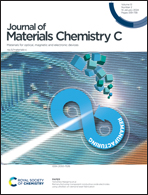Photoluminescence and structural phase transition relationship in Er-doped BaTiO3 model ferroelectric system†
Abstract
When embedded within a ferroelectric host matrix, rare-earth ions and their photoluminescence (PL) provide an original all-optical light probe for temperature, electric field and mechanical stimulus. However, a clear and global view of how PL is affected by the phase transitions that are inherent to ferroelectric materials is still lacking. Here, using an Er-doped BaTiO3 model ferroelectric material, we demonstrate that the PL of the green emission bands resulting from a 488 nm light excitation exhibit changes at the critical ferroelectric transitions. The transition temperatures also have a signature on the absolute temperature sensitivity we extracted from the ratio of the two main green emission bands. Furthermore, we demonstrate that the sub-peaks related to the lifting of degeneracy by the crystal field also contain information on the phase transitions. We propose that the intensity ratio and the wavelength position difference of some of these sub-peaks can be used as order parameters to describe the phase transitions. We hope our results will help better understand the link between light emission features and local polar and macroscopic structures.



 Please wait while we load your content...
Please wait while we load your content...